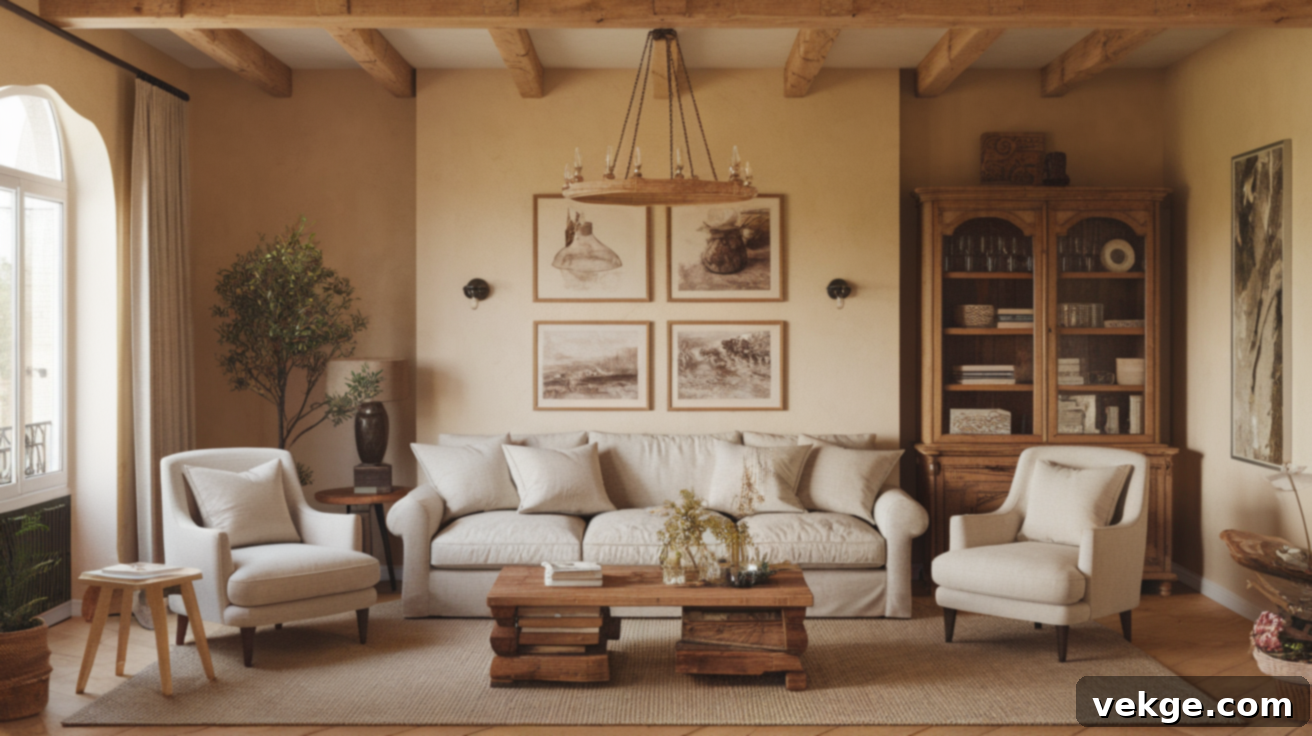Creating Your Dream Home: The Essential Guide to French Farmhouse Style & Decor
The allure of French farmhouse style lies in its inherent ability to blend rustic simplicity with understated elegance, creating spaces that feel both refined and deeply welcoming. Unlike styles that demand pristine perfection, French farmhouse celebrates the beauty of imperfection, valuing natural materials, gentle color palettes, and cherished items that gain character and appeal with age. This design philosophy effortlessly combines the charm of old-world aesthetics with the comforts of modern living, resulting in homes that are not only beautiful but also incredibly functional and inviting.
This comprehensive guide will delve into the defining characteristics of French farmhouse style, offering inspiration for every room in your home. We’ll share practical, budget-friendly tips, explore delightful DIY projects, and reveal the best places to discover those perfect, authentic pieces. Are you ready to transform your living space into a French farmhouse retreat that feels both unique and authentically lived-in? Let’s embark on this journey, starting with the foundational elements that make this style so captivating.
Understanding the Essence of French Farmhouse Style
At its heart, French farmhouse style is about creating an environment that feels collected, curated, and cherished over time. It’s a design ethos that prioritizes comfort, warmth, and the tactile beauty of natural elements. Walls often serve as a soft, unassuming canvas, typically rendered in creamy whites, gentle off-whites, or serene pale blues. These subtle backdrops allow the richer textures and forms of the furnishings and decor to truly shine.
Natural materials are undeniably the protagonists of this style. Raw, unfinished, or lightly distressed wood is ubiquitous, gracing floors, handcrafted furniture, and striking ceiling beams. These wooden elements often proudly display the marks of their history – an aged patina, subtle dents, or natural knots – adding unparalleled character and a sense of enduring authenticity. Stone surfaces further enhance this connection to nature, particularly in functional spaces like kitchens and around grand fireplaces, effectively blurring the lines between indoor comfort and the rugged beauty of the outdoors.
A key differentiator of French farmhouse homes is their embrace of antique and time-worn finishes. Furniture pieces are rarely factory-new; instead, they often feature subtle signs of wear, such as gently chipped paint, faded upholstery, or a lovingly polished surface. These imperfections tell a story, hinting at generations of use and care, and imbue spaces with a profound sense of history and warmth. Exposed wooden beams, whether original structural elements or decorative additions, are perhaps one of the most iconic and instantly recognizable features. These robust architectural details ground the room, draw the eye upward, and are frequently complemented by textured plaster walls that provide subtle depth without overwhelming the senses, reinforcing the style’s rustic yet refined appeal.
French Farmhouse vs. French Country vs. Modern Farmhouse: A Clarification
The vast world of interior design frequently features styles that, at first glance, appear remarkably similar, yet possess distinct characteristics. Understanding the nuanced differences between French Farmhouse, French Country, and Modern Farmhouse is crucial for achieving your desired aesthetic. Here’s a comparative breakdown to illuminate their unique qualities:
| Feature | French Farmhouse | French Country | Modern Farmhouse |
|---|---|---|---|
| Colors | Soft whites, creams, pale blues, muted greens, warm grays | Warm yellows, soft reds, lavenders, olive greens, rich ochres | Crisp whites, deep blacks, charcoal grays, natural wood tones |
| Materials | Raw wood, aged stone, wrought iron, linen, cotton, terra cotta | Mixed polished woods, toile fabrics, copper, ornate ceramics | Shiplap, industrial metals (black iron), reclaimed wood, concrete |
| Furniture | Time-worn, often mismatched, simple yet sturdy forms, functional antiques | Curved legs (cabriole), ornate carvings, upholstered pieces, more formal | Clean lines, simpler geometric shapes, oversized comfort, less ornamentation |
| Patterns | Subtle stripes (ticking), delicate florals, minimal patterns, natural textures | Bold florals, elaborate toile scenes, checks, plaids, rooster motifs | Minimal patterns, subtle geometrics, buffalo plaid, natural wood grains |
| Overall Feel | Rustic elegance, humble, authentic, lived-in, cozy, understated charm | Fancy yet comfortable, romantic, opulent, grander, decorative | Clean, bright, updated, minimalist, functional, crisp, contemporary rustic |
| Typical Elements | Large farm tables, exposed wooden beams, slipcovered sofas, ceramic pitchers | Curved settees, floral chintz, gilded mirrors, elegant chandeliers | Black-framed windows, industrial lighting, barn doors, metal accents |
While all three styles draw inspiration from rural living, French Farmhouse distinguishes itself through its emphasis on raw, unrefined beauty and genuine history. French Country leans towards a more decorative and romantic interpretation of country living, often with more intricate details and a richer color palette. Modern Farmhouse, conversely, strips away much of the traditional ornamentation, blending rustic textures with a sleek, contemporary sensibility, often favoring high contrast and streamlined forms. Each style offers a unique path to a beautiful, comfortable home, but the French Farmhouse truly embodies an unpretentious, timeless grace.
French Farmhouse Colors and Materials: The Foundation of Authenticity
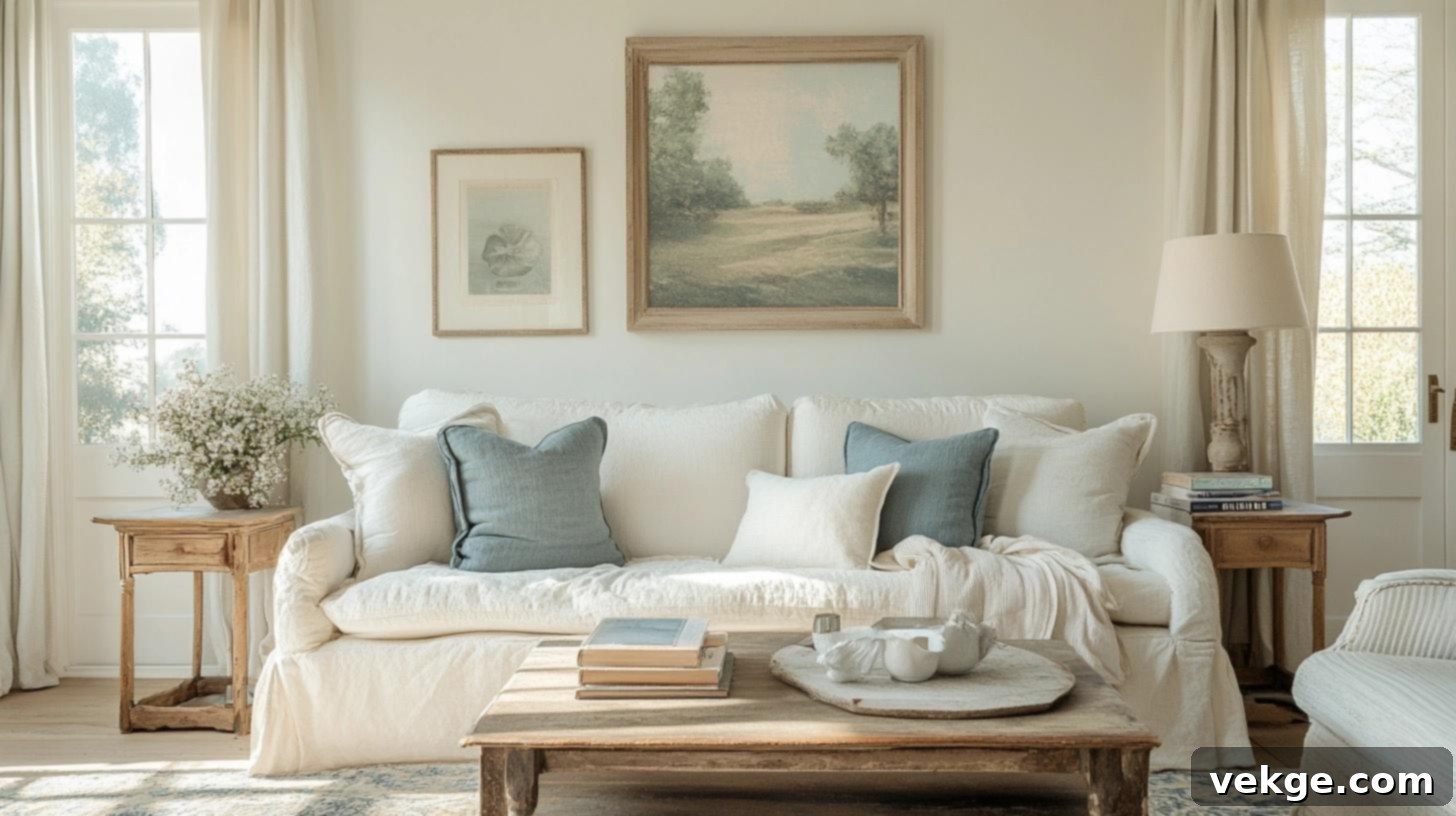
The captivating charm of French farmhouse style is deeply rooted in its carefully chosen palette of colors and an unwavering commitment to natural, tactile materials. This thoughtful selection works in harmony to create spaces that feel inherently warm, genuinely lived-in, and artfully collected over many years, rather than appearing as if they were decorated in a single, planned effort.
Soft Neutrals and Earthy Pastels
The foundational color scheme begins with a symphony of soft, inviting neutrals. Warm whites and creamy off-whites are the quintessential choices for walls, large furniture pieces, and foundational elements. These luminous hues are far from stark; they imbue the home with an immediate sense of light, airiness, and spaciousness, acting as a serene backdrop that allows other elements to gently pop.
Muted blues introduce a subtle yet profound splash of color, reminiscent of the sun-faded shutters on an ancient Provençal cottage, or the hazy, distant blue of rolling hills on a summer’s day. These gentle blues are never overpowering; they create a sense of calm and often find their place on painted cabinetry, an antique armoire, or a collection of ceramic dishes.
Sage greens seamlessly weave natural freshness into the interior, echoing the verdant landscapes of the French countryside. This earthy green pairs exquisitely with the neutral base, often appearing on accent furniture, kitchen island details, or in delicate floral patterns. What unites these colors and makes them so effective is their inherent softness and slightly weathered quality – there’s an absence of anything harsh or jarring, as if each shade has been gently softened and matured by time itself.
Rustic Textures and Organic Materials
Texture is a cornerstone of French farmhouse design, adding depth, warmth, and an irresistible tactile quality. Linen fabric, with its distinctive natural wrinkles and graceful drape, is an absolute staple. It appears everywhere from casually draped tablecloths and flowing curtains to sumptuous bedding, contributing significantly to the relaxed, unpretentious, and effortlessly chic atmosphere.
Stone surfaces, whether on rugged flagstone floors, durable kitchen countertops, or commanding fireplace surrounds, are essential for bringing the elemental beauty of the outdoors inside. The cool, earthy presence of stone adds visual weight and grounding stability, creating a beautiful contrast with softer textiles and lighter wood tones.
Wood, in all its glorious forms, is perhaps the most defining material. From robust ceiling beams and wide-plank floors to sturdy farm tables and antique armoires, wood is celebrated for its natural imperfections. Knots, visible grain patterns, and the subtle wear of time are not hidden but highlighted, each adding a layer of authenticity and unique character that mass-produced perfection simply cannot replicate.
Brushed metal accents, particularly in the form of dark iron or aged brass, provide understated industrial touches. These metals are commonly seen in elegant light fixtures, cabinet hardware, and small decorative objects. Crucially, these metals exhibit a gentle, used appearance rather than a shiny, new luster, further contributing to the home’s aged charm.
The concept of patina – the beautiful transformation and aging of materials over time – acts as the unifying thread for all these elements. Slightly worn edges, sun-kissed faded colors, and surfaces that bear the subtle marks of years of loving use are what forge the authentic, soul-stirring charm for which French farmhouse style is renowned. It’s a celebration of life lived within those walls, making every object a story-teller.
Room-by-Room Styling Ideas for Your French Farmhouse Home
Transforming your home into a French farmhouse haven is an exciting journey. These practical, room-by-room styling suggestions will guide you in creating cohesive and charming spaces, with simple yet impactful changes.
Living Room: Comfort Meets Casual Elegance
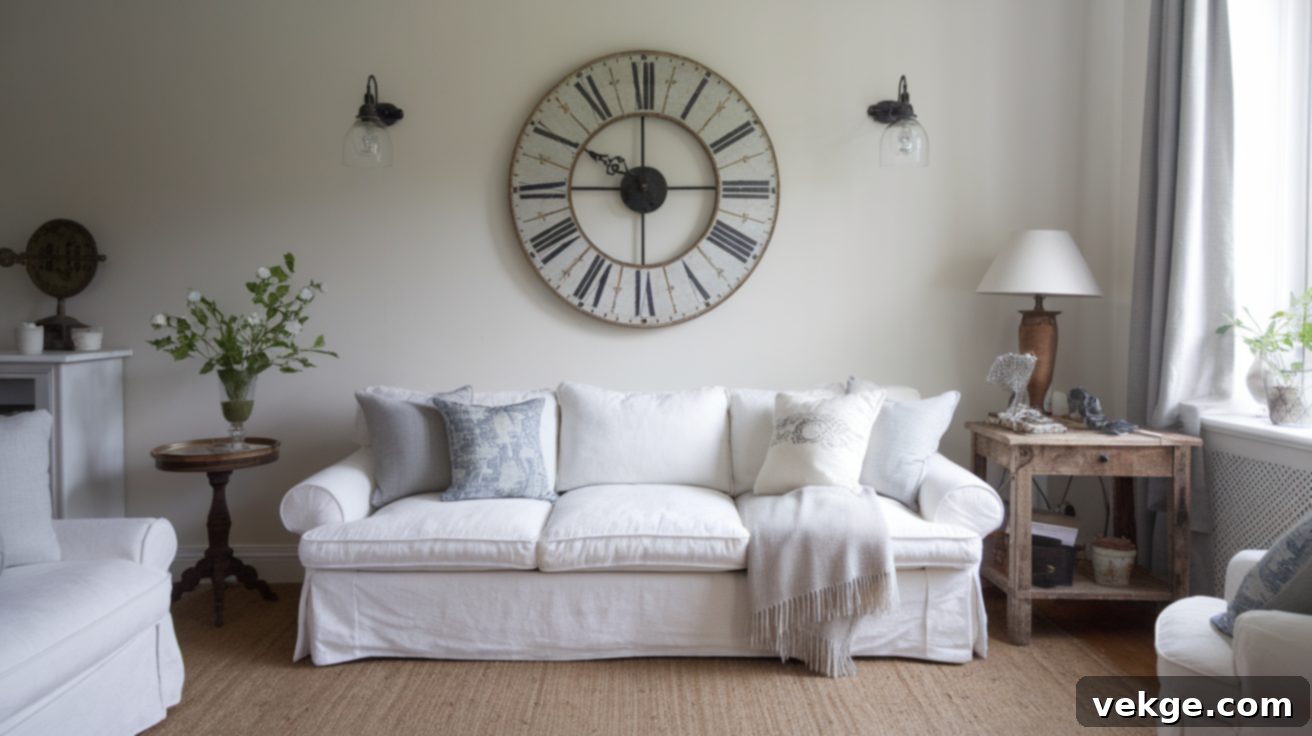
The French farmhouse living room is the epitome of comfort and understated beauty. Central to this space are large, inviting sofas, often slipcovered in crisp white, natural linen, or muted cotton, offering both timeless style and practical washability. These foundational pieces invite relaxation and conversation.
Infuse the room with character by incorporating one or two carefully chosen vintage finds, such as an antique wooden chest that doubles as a coffee table, an old grandfather clock, or a beautifully worn side table. Layering is key to warmth: think plush wool throws casually draped over armrests and an assortment of linen pillows in soft blues, creams, or subtle stripes. A large, natural fiber rug (jute or sisal) anchors the space, adding texture without distracting from the overall serene palette. Soft, diffused lighting from table lamps with linen shades or wall sconces creates an intimate and welcoming glow, completing the lived-in feel.
Kitchen: The Heart of the Home, Rustic and Functional
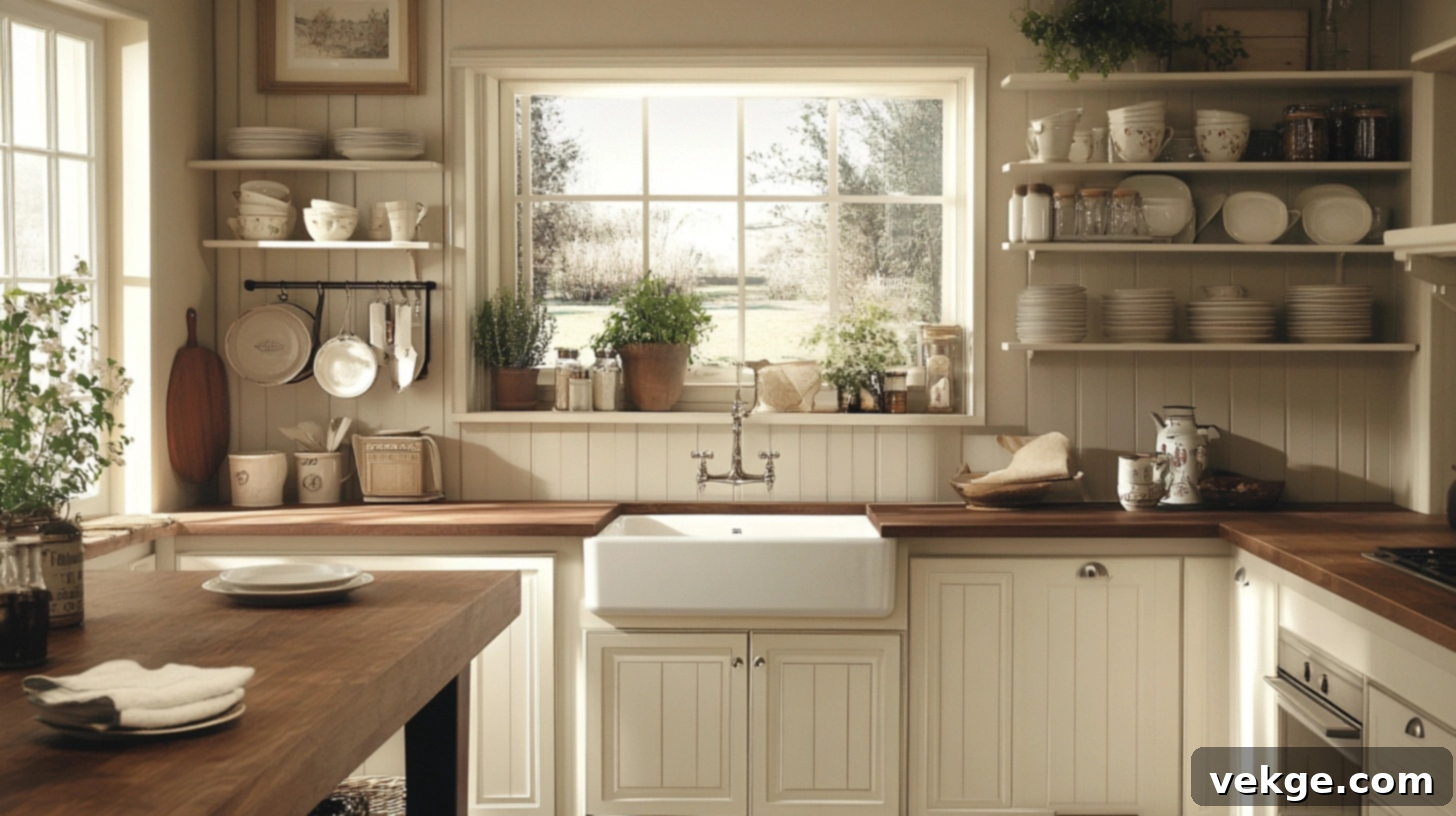
The kitchen in a French farmhouse home is not just a place for cooking; it’s a central gathering space, brimming with warmth and utility. The iconic farmhouse sink, typically a large, white porcelain basin with a prominent apron front, serves as a quintessential focal point. Its substantial presence speaks to both functionality and enduring charm.
Open shelving is a hallmark, proudly displaying everyday dishes, stacks of pristine white plates, and beautifully worn cooking items, turning practical necessities into decorative elements. Butcher block countertops, with their natural warmth and capacity to acquire a beautiful patina over time, perfectly embody the practical, unfussy ethos of the style. Introduce elements like wrought iron pot racks, vintage-inspired faucets, and a simple kitchen island with turned legs to enhance the rustic aesthetic. Baskets for storage and fresh herbs on the windowsill further contribute to the inviting, functional ambiance.
Bedroom: A Serene Retreat of Quiet Luxury
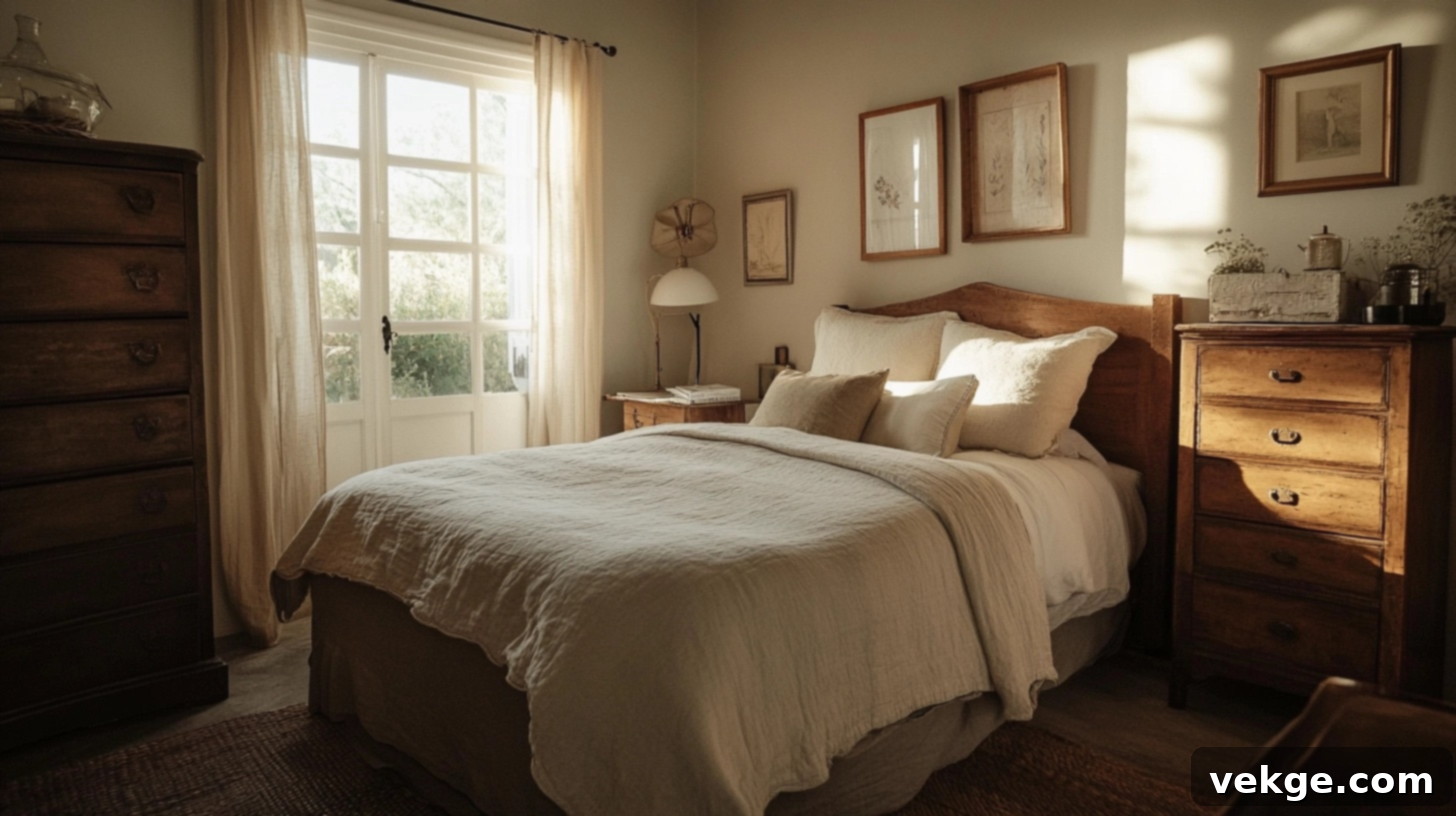
The French farmhouse bedroom is a sanctuary designed for tranquility and understated luxury. The bed, often a simple wooden frame or an elegant iron design, is dressed in layers of crisp yet soft linen or pure cotton sheets, predominantly in soothing whites or creams. A lightweight duvet or a subtly textured quilt completes the inviting look.
Soft, ambient lighting is crucial for creating a serene atmosphere. Small table lamps on nightstands or gently glowing wall sconces cast a warm, diffused light. Instead of modern closets, antique dressers or armoires with slightly worn finishes provide storage while infusing the room with a sense of history and unique character. A simple, upholstered bench at the foot of the bed or a vintage mirror on the wall adds functional beauty without cluttering the space, ensuring the room remains a calm and restorative haven.
Dining Room: Gathering with Rustic Grace

The French farmhouse dining room is where formal gatherings meet casual comfort. It’s designed to host lively meals and intimate conversations. A large, sturdy wooden table, often crafted from reclaimed wood or featuring a natural, lightly whitewashed, or distressed finish, serves as the undeniable anchor of the space. Its generous proportions invite communal dining and lasting memories.
Chairs need not be a perfectly matched set; indeed, a charming mix of wooden chairs, perhaps with some featuring upholstered linen seats, adds visual interest and a collected feel. Overhead, a rustic chandelier, possibly made of wrought iron or aged wood with simple candles, provides warm, inviting light and acts as a central statement piece without being overtly flashy. A simple linen table runner, antique serving pieces, and fresh flowers in a ceramic pitcher complete the look, creating an atmosphere that is both elegant and unpretentiously welcoming.
Bathroom: Old-World Charm with Modern Simplicity
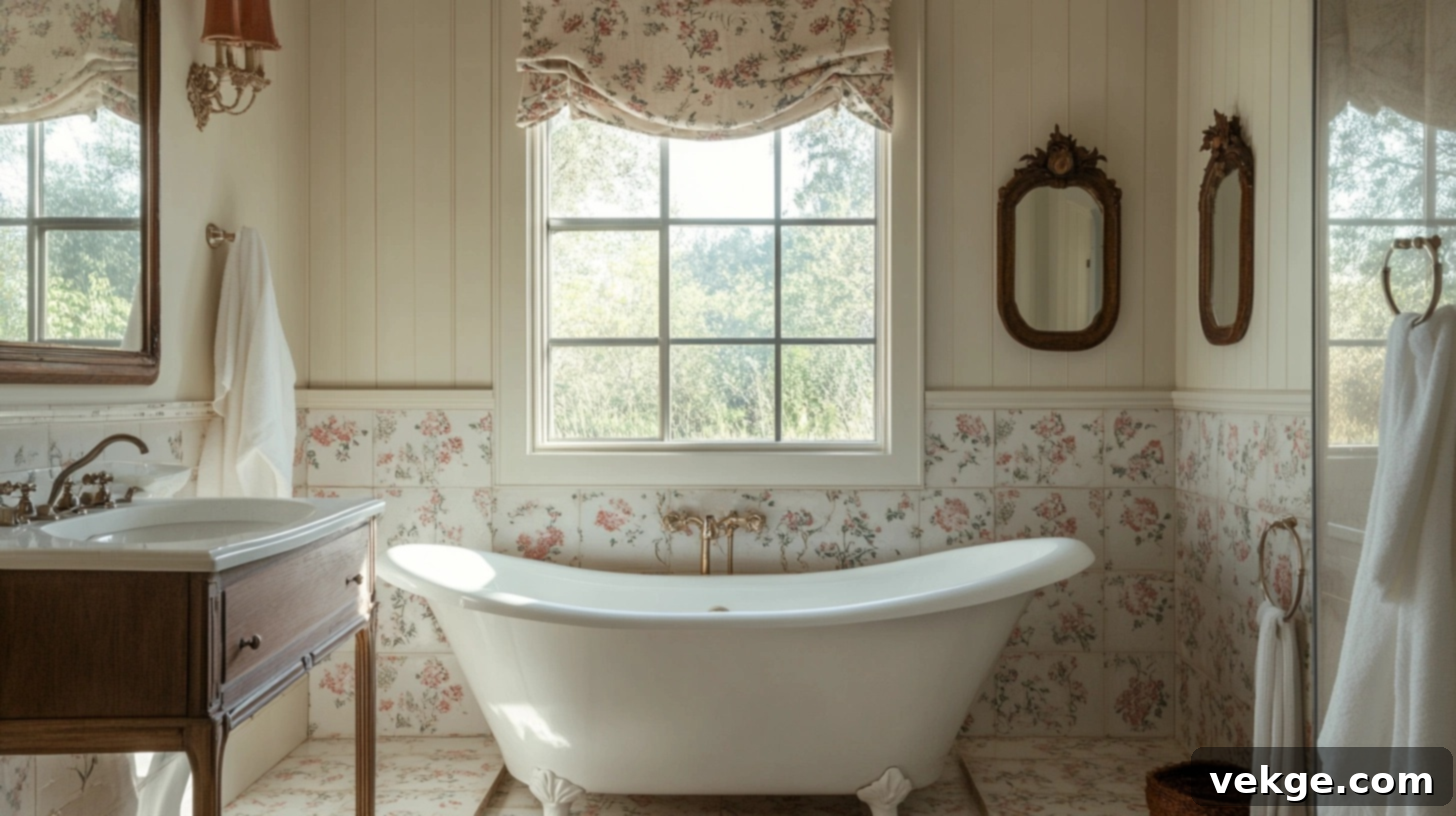
The French farmhouse bathroom is a harmonious blend of old-world charm and refreshing simplicity, creating a space that feels both luxurious and authentic. A freestanding clawfoot tub, often cast iron with an enamel finish, becomes an instant focal point, offering both practical utility and a stunning visual statement that evokes a bygone era.
Flooring can feature simple hexagonal or floral tiles in muted, natural colors, adding subtle pattern and texture without overwhelming the typically smaller space. Vintage-inspired fixtures in aged brass or brushed nickel complement the historical aesthetic. A large vintage mirror with a beautifully aged, ornate frame reflects light and adds a profound sense of history, contrasting beautifully with the clean lines of a modern sink or a simple wooden vanity. Open shelving with neatly folded linen towels, glass jars filled with bath salts, and a sprig of lavender complete this serene and charming retreat.
Decor Essentials and Styling Tips for Authentic French Farmhouse Flair
Achieving an authentic French farmhouse aesthetic doesn’t require a complete overhaul. Incorporating these signature decor items and applying these styling techniques will infuse your home with rustic charm and timeless elegance, often with minimal effort.
Signature Decor Items that Define the Style
- White or Cream Ceramic Pitchers and Vases: These simple, elegant vessels are instant character builders. Whether holding a casual bouquet of wildflowers, dried lavender, or standing alone as sculptural pieces on a shelf, mantel, or kitchen counter, their classic shapes and neutral tones bring undeniable farmhouse charm to any room. Look for varying sizes and subtle textures.
- Ladder Shelves and Open Storage: Offering casual yet chic display space, ladder shelves maintain an airy feel and prevent rooms from becoming heavy. Utilize them to showcase neatly stacked white dishes, a collection of small potted herbs, vintage books with worn covers, or cherished antique finds. This open display method makes items feel both useful and decorative.
- Framed Botanical Prints: These subtle art pieces effortlessly bring the beauty of nature indoors. Seek out simple, delicate drawings or etchings of herbs, wildflowers, or garden vegetables, rendered in soft, muted colors. Display them in frames that show a bit of age – perhaps distressed wood or slightly tarnished metal – to achieve that coveted “collected-over-time” look that is so essential to French farmhouse appeal.
- Wrought Iron Elements: From elegant curtain rods to rustic candle holders, wrought iron adds a touch of classic French craftsmanship and durability. Its dark, sturdy presence provides a wonderful contrast to softer textures and lighter colors.
- Baskets: Woven baskets in various sizes and natural fibers (wicker, rattan, seagrass) are indispensable for both storage and adding texture. Use them for throws, magazines, or even as decorative planters.
Mastering the Art of Mixing Old and New
The true magic of French farmhouse lies in its ability to gracefully blend the past with the present. To achieve this, start by selecting one or two standout antique pieces for each room. This might be a magnificent wooden cabinet, a robust farm table, or a vintage armoire. These pieces will anchor your space with rich history and undeniable character, becoming natural focal points.
Balance these historic elements with carefully chosen new pieces that don’t compete for attention but rather complement. Modern upholstered sofas or comfortable armchairs in neutral tones, for instance, pair beautifully with antique wooden tables, creating a welcoming and functional living space that feels current without losing its historical soul. When selecting new items, prioritize natural materials and simple, timeless lines. Pieces crafted from solid wood, linen, or metal, with unembellished designs, will seamlessly integrate with genuine antiques, ensuring a cohesive and authentic French farmhouse aesthetic that feels genuinely lived-in, not stuck in a particular era.
Fabrics and Prints: Subtle Elegance
- Ticking Stripes: This classic fabric, characterized by thin, evenly spaced lines on a cream or natural background, is deeply rooted in the history of rural French homes. Use ticking stripes on pillows, chair cushions, curtains, or even as a simple bedskirt to add subtle pattern and a touch of timeless authenticity without overwhelming the space.
- Toile de Jouy: Toile fabrics, featuring single-color pastoral scenes (often blue, red, or black on a cream background), bring a distinct visual interest and a touch of romanticism. To keep the look balanced and avoid overwhelming a room, use toile sparingly – perhaps on a single accent chair, a few throw pillows, or even framed as a piece of textile art.
- Soft Floral Patterns: Unlike bold, contemporary florals, French farmhouse floral patterns are typically muted, faded, and understated. These gentle prints, often featuring small, delicate motifs in soft colors, add subtle texture and a whisper of natural beauty. They contribute to a harmonious and serene atmosphere rather than creating sharp contrasts, perfectly embodying the style’s graceful charm.
- Linen: As previously mentioned, linen is paramount. Its natural wrinkles, durability, and soft drape are essential. Use it for almost all textiles – curtains, tablecloths, bedding, and upholstery – to create a relaxed, inviting, and sophisticated feel.
Budget-Friendly Ideas and DIY Projects for Your French Farmhouse Home
Creating a beautiful French farmhouse home doesn’t have to break the bank. With a little creativity and some elbow grease, you can infuse your space with authentic charm using budget-friendly ideas and rewarding DIY projects.
Distressed Paint Techniques: This is a powerful method for giving ordinary furniture pieces instant, authentic farmhouse charm. Start with solid wooden items – perhaps an old dresser, a small side table, or a set of dining chairs – that have good bones but lack character. Apply a base coat of white, cream, or pale blue chalk paint. Once completely dry, use fine-grit sandpaper or a sanding block to lightly distress the edges, corners, and areas that would naturally show wear over time. This process reveals subtle hints of the underlying wood or a previous paint layer, creating that coveted worn, loved look that is a hallmark of French farmhouse style. You can also use a “resist” technique by applying wax before your top coat, then scraping the paint away for a chippy look.
Thrift Flips for Secondhand Treasures: The hunt for secondhand finds is central to the French farmhouse aesthetic. Look for solid wood furniture at flea markets, antique shops, and yard sales. Don’t be deterred by dated finishes or minor imperfections. A sturdy wooden frame with good structure can be completely transformed with minimal cost. Simple updates like replacing old hardware with aged brass or wrought iron pulls, adding custom-made linen cushions to an old chair, or giving a dark, heavy piece a fresh coat of chalk paint can breathe new life into older items. Look for ceramic pitchers, old wooden cutting boards, vintage mirrors, or simple glass jars that can be repurposed.
Homemade Decor Adds Personal Touches: Nothing says “loved home” quite like handmade decor. These projects add unique personal touches that no store-bought item can replicate, all while keeping your budget intact.
- Linen Table Runners: Purchase a length of natural linen fabric, cut it to your desired size, and leave the edges raw or fray them slightly for a wonderfully rustic, undone look.
- Dried Herbs and Flowers: Gather sprigs of rosemary, lavender, or eucalyptus from your garden or a local market. Tie them with twine and hang them to dry, then display them in clear glass jars, ceramic pitchers, or simply hang them from a kitchen rack.
- Pressed Flowers: Collect wildflowers or garden blooms and press them between heavy books. Once dry, frame them in thrifted, aged frames for delicate and personal botanical art.
- DIY Wall Art: Use stencils to create simple patterns or French phrases on canvas or wooden boards, or simply frame vintage postcards or pages from old French books.
These hands-on elements infuse your home with warmth, story, and a sense of genuine care, perfectly embodying the spirit of French farmhouse living.
Seasonal Styling Ideas: Adapting Your French Farmhouse Home Year-Round
One of the beauties of French farmhouse style is its effortless adaptability to the changing seasons. With just a few thoughtful adjustments in color, texture, and natural elements, your home can feel continuously refreshed and aligned with the rhythm of nature, all while maintaining its core aesthetic of timeless charm and rustic elegance.
Spring and Summer: Embracing Lightness and Freshness
As the days lengthen and warm, French farmhouse homes naturally lean into a lighter, airier feel.
- Lightening the Palette: Pull back heavy curtains to allow abundant sunshine to flood your space, highlighting the soft whites, creams, pale blues, and gentle greens already present. Consider swapping darker decorative accents for lighter ones.
- Airy Fabrics: Refresh rooms without major overhauls by switching out heavier textiles. Replace plush wool throws with lightweight linen blankets or soft cotton throws. Introduce new pillow covers in cotton with subtle ticking stripes, small floral patterns, or a simple chambray blue for a seasonal update. Linen slipcovers on furniture are particularly refreshing.
- Fresh Floral Displays: Fresh flowers become paramount decor elements. Display them simply in ceramic pitchers, clear glass bottles, or rustic terra cotta pots. Opt for loose, natural arrangements that look as if they were just casually gathered from a garden – think lavender, peonies, hydrangeas, or sprigs of olive branches – rather than formally designed bouquets. The scent of fresh flowers further enhances the spring/summer ambiance.
- Outdoor Living: Extend your French farmhouse style to your patio or garden with simple wrought iron furniture, potted herbs, and a string of warm white fairy lights for evening ambiance.
Fall and Winter: Cultivating Warmth and Cozy Comfort
When the colder months arrive, the French farmhouse home transforms into a sanctuary of warmth, coziness, and inviting comfort.
- Warm Lighting: Create an intimate glow during darker evenings with an abundance of warm candles. Group different heights of pillar candles or votives in simple holders on wooden trays, stone surfaces, or mantels for maximum impact with minimal fuss. Ambient lamplight becomes even more important.
- Rich Textures and Layering: Introduce more substantial, tactile textures. Drape chunky knit wool throws or sheepskin rugs casually over chairs and sofas, inviting family and guests to curl up. Linen bedding can be layered with a heavy quilt or a luxurious velvet throw in a deep, muted tone like sage green or warm gray.
- Natural Elements: Bring nature indoors even when gardens are dormant. Dried floral wreaths crafted from hydrangeas, lavender, or wheat stems add subtle seasonal touches to mantels, doors, or an empty wall. Pinecones, branches of berries, or a bowl of seasonal fruits (like pomegranates or apples) further honor the style’s rural roots and seasonal shifts.
- Scent: Introduce comforting scents with diffusers featuring notes of vanilla, cinnamon, or pine, or simply simmer a pot of spices on the stove.
These thoughtful, seasonal changes ensure your French farmhouse home remains a welcoming, beautiful, and deeply connected space throughout the year.
Final Thoughts: Embracing the Story of Your Home
The true heart of French farmhouse style isn’t found in strict adherence to rules or the acquisition of specific, high-end items. Rather, it flourishes in the thoughtful collection of pieces that resonate with your personal story, evoke cherished memories, and genuinely bring you joy. This style is an ongoing narrative, one that unfolds beautifully over months and years as you slowly discover and integrate special items, each contributing to the unique character of your home.
Embrace the imperfections: the small scratches on a wooden table, the gentle fading of a linen throw, the slight chip on a ceramic pitcher. These are not flaws but rather badges of honor, testaments to a home that is genuinely lived in, loved, and enjoyed. They contribute to the authentic, soulful charm that defines the French farmhouse aesthetic.
Begin your journey with just one or two carefully chosen pieces in each room, allowing your spaces to evolve organically. Add more only when you find something that truly speaks to you and makes your heart sing. Your French farmhouse should be a reflection of your real life, celebrating its unique quirks, comforts, and stories. It’s about creating a sanctuary that feels effortlessly elegant, profoundly comfortable, and authentically yours.
Frequently Asked Questions About French Farmhouse Style
What makes a French farmhouse different from a modern farmhouse?
French farmhouse style is characterized by its softer color palettes (creams, pale blues, muted greens), a strong emphasis on genuine antiques and vintage finds, and a preference for graceful, often curved, furniture shapes and natural patinas. It aims for a look that feels authentically aged and “collected over time.” In contrast, modern farmhouse features sharper contrasts, often relying on crisp white and black, cleaner lines, and simpler, less ornate details. While both embrace natural materials like wood, modern farmhouse incorporates more industrial elements and a sleeker, more contemporary aesthetic, focusing on updated functionality and open, minimalist spaces.
Is French farmhouse style suitable for small spaces?
Absolutely! French farmhouse style is wonderfully adaptable to smaller homes and apartments. Its reliance on light color palettes (which make spaces feel larger and brighter), multifunctional furniture (like a vintage trunk that doubles as a coffee table), and carefully curated, simple decorative elements actually makes it ideal for maximizing space and creating an airy, uncluttered feel. The key is to focus on fewer, high-quality, meaningful pieces rather than filling every corner. Utilize vertical space with open shelving or ladder shelves, and choose furniture with visible legs to keep the floor plan feeling open and expansive.
Can I successfully mix French farmhouse with other popular decor styles like Scandinavian or Boho?
Yes, mixing French farmhouse with other styles can create a unique and personalized look, especially with Scandinavian and Boho decor. French farmhouse blends beautifully with Scandinavian design due to their shared appreciation for natural materials, light wood tones, a neutral color palette, and an emphasis on comfort and simplicity. To combine them, focus on clean lines from Scandinavian pieces and the rustic textures of French farmhouse. When mixing with Boho, French farmhouse can provide a sophisticated backdrop. The textured fabrics, global patterns, and relaxed vibe of Boho decor can be introduced through textiles, rugs, and plants, while the French farmhouse elements provide structure and timeless charm. The key to successful blending is maintaining a cohesive color palette, focusing on natural materials, and ensuring that both styles share common elements like comfort and a connection to nature.
